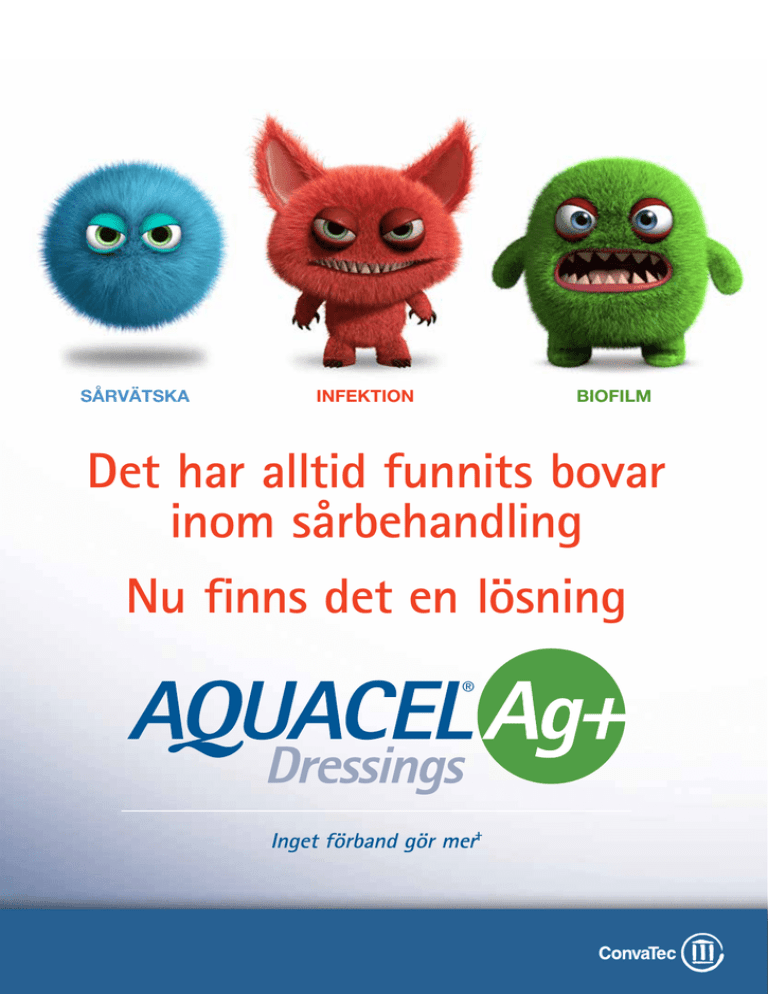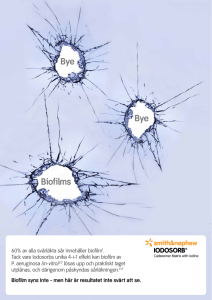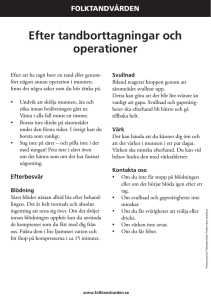Det har alltid funnits bovar inom sårbehandling Nu finns
advertisement

Sårvätska INFEKTION Biofilm Det har alltid funnits bovar inom sårbehandling Nu finns det en lösning ® Inget förband gör mer† Inget förband gör mer† 3 2 1 Tre bovar inom sårbehandling: sårvätska, infektion och biofilm Två effektiva teknologier Den nya Ag+ teknologin En revolutionerande teknologi som bryter ner biofilm och dödar bakterier som orsakar infektion.*1-3 Hydrofiber® teknologi En beprövad teknologi som absorberar och binder in sårvätska för att skapa en optimal sårläkningsmiljö.*4-8 En lösning för sårläkning ® *Som visats in vitro †Dokumenterad förmåga att hantera sårvätska, infektion och biofilm. Biofilm fördröjer sårläkningen Biofilm är vanligt Biofilm bildas när kolonier av bakterier utsöndrar ett slemlager för att skydda sig själva.9 Biofilm förekommer vid omkring 80% av alla infektioner inom sjukvården.10 Dental plack, urinvägsinfektioner och ögoninfektioner är alla associerade med biofilm.11-13 Även om det inte alltid är synligt så förekommer biofilm i majoriteten av alla svårläkta sår14 – och det är en vanlig orsak till fördröjd sårläkning15 samt infektion.16 Biofilm är svår att helt få bort17 – även med debridering – och den återbildas snabbt.18 Biofilm står emot: •Antimikrobiella medel som PHMB**19, honung20, jod21,22 och silver23 •Antibiotika24 •Kroppens egna försök att rensa upp i såret25 för att få igång sårläkningen.19 Misstänkt biofilm Biofilm genom mikroskop **polyhexametylenbiguanid Alla bilder används med tillstånd av respektive ägare. Biofilm Biofilmen är envis Två effektiva teknologier som tills förekommande hinder för sårläkn Ag+ teknologin är en unik teknologi med effekt på biofilm som:26 •LÖSER UPP och bryter ner biofilm och exponerar bakterier*1-3 •DÖDAR ett brett spektrum av bakterier - inklusive antibiotikaresistenta bakterier - med sitt innehåll av silver*2,3,27 •FÖRHINDRAR återbildning av biofilm.*2,3 Aquacel® Ag+ Extra (n=5) Aquacel® Ag Extra (n=5) Acticoat 7 (n=5) Re-inokulering Livsdugliga bakterier (CFU) I en in vitromodell med biofilm uppvisade AQUACEL® Ag+ Extra förband överlägsen förmåga att bryta ner och förhindra återbildning av biofilm.28-30 30 000 000 000 3 000 000 000 300 000 000 30 000 000 3 000 000 300 000 30 000 3 000 300 Inga detekterade 024487296120 144 Tid (timmar) Löser upp biofilm/dödar bakterier Förhindrar återbildning av biofilm MRSA Livsdugliga bakterier (CFU) Bevisat i laboratorium Pseudomonas aeruginosa 30 000 000 000 3 000 000 000 300 000 000 30 000 000 3 000 000 300 000 30 000 3 000 300 Inga detekterade 0 24 48 72 96 120 Tid (timmar) Löser upp biofilm/dödar bakterier 144 168 192 216 Dag 9 Förhindrar återbildning av biofilm I denna in vitro-modell odlades mogen biofilm fram på gasvävssubstrat och bekräftades med mikroskopering. Biofilmssubstraten överfördes sedan till agarplattor för att skapa en simulerad sårmodell med biofilm, förband lades på biofilmsytan, hydrerades och täcktes med ett lämpligt ytterförband. Efter inkubering bedömdes förbandets dödande effekt på bakterierna i biofilmen vid flera tidpunkter under 120 timmar. Även återbildningen av biofilm bedömdes genom inokulering av färska bakterier på gasvävssubstratet under förbandet, följt av en utvärdering av närvaro eller frånvaro av biofilm under upp till 96 timmar. *Som visats in vitro sammans bekämpar vanligt ning. Hydrofiber® teknologin bidrar till att skapa en optimal miljö för sårläkning och säkerställer att Ag+ teknologin fungerar. •BINDER IN sårvätska, bakterier och biofilm för att minska risken för smittspridning och förhindra maceration*4-7,31,32 •FORMAR SIG efter sårbäddens konturer för att upprätthålla en optimal fuktbalans och eliminera utrymmen där bakterier och biofilm kan växa*33-35 •REAGERAR på sårmiljön genom att bilda en sammanhängande gel, vilket minskar smärtan vid förbandsbyten*36-38 Extra absorptionsförmåga ger längre användningstid*39-41 Extra styrka förenklar borttagandet*39 Aquacel® Ag+ band Aquacel® Ag+ Extra® förband ® *Jämfört med AQUACEL® Ag förband – support ® Bevisat i vetenskapligt kontrollerade sår Signifikant större reduktion av biofilm i jämförelse med ett PHMB förband.41 95 % Medeltal av livsdugliga bakterier (CFU/sår) (n=6) I en anpassad sårmodell - in vivo - med biofilm19 visade Ag+ teknologin i kombination med Hydrofiber® teknologi:* 100 000 000 10 000 000 1 000 000 100 000 10 000 större reduktion dag 6 (p<0,05) epitelvävnad jämfört med ett PHMB förband.41 48 % ■PHMB förband ■ AQUACEL® Ag+ förband Yta med granulationsvävnad (mm2) (n=18) större mängd Signifikant granulationsvävnad och 2 46 Antal dagars behandling 140 120 100 80 60 40 20 0 PHMB förband AQUACEL® Ag+ förband PHMB förband AQUACEL® Ag+ förband mer granulationsvävnad dag 6 (p<0,05) 24 % mer epitelvävnad dag 6 (p<0,05) *AQUACEL® Ag+ förband användes i denna studie Yta med epitelvävnad (mm2) (n=18) 140 120 100 80 60 40 20 0 terar sårläkning Visad sårläkning i klinisk miljö 42 54 % 70 % reduktion av sårytan för alla sår % reduktion av sårytan I en prospektiv, icke-jämförande multicenterstudie på 42 patienter med svårläkta, venösa bensår där sannolikheten för biofilm var stor på grund av sårinfektion eller sår med ökad risk för infektion, visade Ag+ teknologin i kombination med Hydrofiber® teknologi:* –20 –10 0 10 20 30 40 50 60 70 80 0 reduktion av sårytan för de infekterade såren 1 2 3 4 AQUACEL® Ag+ förband 6 7 8 AQUACEL® förband ■ Alla sår ■ Infekterade sår Dag 1 Dag 28 Dag 49 – läkt Dag 1 Dag 22 Dag 56 – läkt 10 sår med infektion och 32 sår med ökad risk för infektion *AQUACEL® Ag+ förband användes i denna studie 5 VECKOR Alla bilder används med tillstånd av respektive ägare. AQUACEL® Ag+ förband Inget förband gör mer Wounds that Använd AQUACEL® Ag+ förband vid behandling av svårläkta och akuta sår som är infekterade eller med risk för infektion. Protocol of Care for Effec risk of infec tive Use tion are infec ted, or at Fig. 1 Diabetic wound foot ulcer showing infectionbed and presenc a sloughy on the . Evidence of e of localised wound devitalis bed. ed tissue Images 1 2 reproduced ASSESS with kind permission of R Mathison, Stockport Fig. 2 NHS Trust, Stage 4 colonise pressure ulcer with a a suspectd, sloughy wound heavily ed layer of biofilmbed, and (right). UK (Fig. Evaluat e both 1), D Copson, Nottingham University Hopitals Cleanse and the pati ent and GE 3 approp accord riate debride ing to • Mechan the wound and ment method patient cotton ical, e.g. using goals: 3,4 pad. gauze • Larval or therapy . • Ultraso nic, surgica † hydrosurgical, l. sharp, • Apply an wound AQUACEL ™ Ag+ dressin preven to disrupt biofilm t g exudat biofilm reform , kill bacter to the e and infectio ation* 1,2 ia, • Cover whilst and n. manag with an ing AQUAC EL ™ Foam dressin g. Extra ™ Infected exuding leg ulcer which surroun causing maceratis heavily ding skin. with areas Dull red ion to the or Ribbon the wou nd. Fig. 4 Minor traumat chronic ic ulceratio injury resulting n and infection in . debride . Dress. MANA Fig. 3 NHS Trust, of slough. UK (Fig. wound 2), D Nelson, • Carry bed Derby Hospitals out a holistic NHS Foundation • Assess patient Trust (Fig 3&4). the wound assess ment, : • Wound e.g. co-mo rbiditie • Wound type. s, medica bed appea tion etc. • Size rance (tissue (length , width, • Exudat type and depth) e %: slough • Associ (colour, consist . , necros ated pain ency, level). is, granula • Peri-w ound skin and/or odour. tion, biofilm • Signs conditi ). on (swellin and sympto ms of infectio g, discolo uration n (pain, , macer odour, heat, rednesation). s, swellin g, purulen ce). Cleanse • Cleans and Debr e • Irrigate necess and debride with water ide Tips ary to approp e.g. slough remove the wound or cleanse riate Irriclens ™ wound cleanse with an , necros barriers to where healing is, biofilm cleanse r e.g. • Select , r. . the + (with strength ening fibre) Adhesiv e or non-adh esive dressing dressing Dressing Tips ‡ • AQUAC ™ overlap EL Ag+ Extra ™ dressin surroun at least 1 cm g should onto ding • For cavity the wound. the skin wounds dressin Dehisced surgical with suspected wound prior to biofilm debridem ent. Wound post using a debridement curette. g is recommAQUACEL ™ • When Ag+ Ribbon ended. dressin g deep 80% to wounds contac allow for dressin only t with wound g expans fill to • When ion on using AQUAC fluid. dressin EL ™ g, outside leave 2.5 cm Ag+ Ribbon of • The absorbthe cavity to length of ribbon aid remova ent pad dressin l. of AQUAC g least 1 should overlap EL ™ cm. the woundFoam by at Reasses at eac s and doc h dres ument sing cha the wou nge. nd • If the wound or AQUAC remains EL ™ Ag+ infected or • For a at risk Ribbon shallow of infectio dressin and second wound g covere n continu d with e to use ary dressininfected or at • If an AQUAC g combin risk of infectio AQUACEL ™ antimic EL ™ Ag+ Foam robial dressin ation, use dressin n dressin Extra ™ * As demonstrated g AQUAC and no longer g. dressin in combination g is no longer in vitro †Require EL ™ Ag requirin specialist g alone. Foam dressin g the use with AQUAC require skills and ‡Refer to equipment. product of a primar pack insert(s) Reference: Referral EL ™ Foamd, use AQUAC g. to the appropriate for complete formation 1. WHRI3850 y directions EL ™ by Ag+ MA232: specialist dressin Debridement EXTRA. may be 2013. Physical Disruption for use. g, or for Extra ™ or AQUAC required. TM indicates Made Easy. WoundsData on file, ConvaTecof Biofilm by AQUACEL a shallow a trademark UK. 2011;7(4). Inc. 3. of ConvaTec Ag+ Wound Effective Available wound EL ™ Ribbon debridement from www.wounds Dressing. Inc. AQUACEL , AQUAC 2013. in is a registered -uk.com. a changing NHS: Data on file, EL ™ Foam ConvaTec trademark a UK consensus. Inc. of MONIT OR ® ConvaTec En perfekt kombination: och ® Inc. in the US. ©2013 London: ConvaTec Inc. 2. WHRI3857 Wounds UK,2013. MA236: Antimicrobial Available Activity from www.wounds and Prevention AP-014142-M -uk.com. of Biofilm M 4. Vowden ReK, Vowden P. ® StorlekAntal/fpVarunummerStorlekAntal/fpVarunummer AQUACEL® Ag+ Extra 5 cm x 5 cm 10 cm x 10 cm 15 cm x 15 cm 20 cm x 30 cm 4 cm x 10 cm 4 cm x 20 cm 4 cm x 30 cm AQUACEL® Ag+ Band 1 cm x 45 cm 2 cm x 45 cm 10 10 5 5 10 10 10 413566 413567 413568 413569 413581 413598 413599 5 5 413570 413571 AQUACEL® Foam vidhäftande förband 8 cm x 8 cm 10 10 cm x 10 cm 10 420804 420680 12,5 cm x 12,5 cm 17,5 cm x 17,5 cm 21 cm x 21 cm 25 cm x 30 cm 19,8 cm x 14 cm häl 20 cm x 16,9 cm sakral 420619 420621 420623 420624 420625 420626 24 cm x 21,5 cm sakral 5420828 AQUACEL® Foam Icke vidhäftande förband 5 cm x 5 cm 10 420631 10 cm x 10 cm 10 420633 15 cm x 15 cm 5 420635 20 cm x 20 cm 5 420636 15 cm x 20 cm 5 420637 10 10 5 5 5 5 1. Physical Disruption of Biofilm by AQUACEL® Ag+ Wound Dressing. Scientific Background Report. WHRI3850 MA232, 2013, Data on file, ConvaTec Inc. 2. Antimicrobial activity and prevention of biofilm reformation by AQUACEL® Ag+ EXTRA dressing. Scientific Background Report. WHRI3857 MA236, 2013, Data on file, ConvaTec Inc. 3. Antimicrobial activity against CA-MRSA and prevention of biofilm reformation by AQUACEL® Ag+ EXTRA dressing. Scientific Background Report. WHRI3875 MA239, 2013, Data on file, ConvaTec Inc. 4. Newman GR, Walker M, Hobot JA, Bowler PG, 2006. Visualisation of bacterial sequestration and bacterial activity within hydrating Hydrober ® wound dressings. Biomaterials; 27: 1129-1139. 5. Walker M, Hobot JA, Newman GR, Bowler PG, 2003. Scanning electron microscopic examination of bacterial immobilization in a carboxymethyl cellulose (AQUACEL®) and alginate dressing. Biomaterials; 24: 883-890. 6. Bowler PG, Jones SA, Davies BJ, Coyle E, 1999. Infection control properties of some wound dressings. J. Wound Care; 8: 499-502. 7. Walker M, Bowler PG, Cochrane CA, 2007. In vitro studies to show sequestration of matrix metalloproteinases by silver-containing wound care products. Ostomy/Wound Management. 2007; 53: 18-25. 8. Assessment of the in vitro Physical Properties of AQUACEL EXTRA, AQUACEL Ag EXTRA and AQUACEL Ag+ EXTRA dressings. Scientific background report. WHRIA3817 TA297, 2013, Data on file, ConvaTec Inc. 9. Bjarnsholt T, 2013. The role of bacterial biofilms in chronic infections. APMIS. 121. 1-51. 10. Research on microbial biofilms. National Institute of Dental and Craniofacial Research. http://grants.nih.gov/grants/guide/pa-files/PA-03-047.html; Sept. 9, 1997. 11. Marsh PD, Bradshaw DJ, 1995. Dental plaque as a biofilm. J. Industr. Microbial; 15: 169-175. 12. Trautner BW, Darouiche RO, 2004. Role of biofilm in catheter-associated urinary tract infection. Am J Infect Control; 32: 177-183. 13. Elder MJ, Stapleton F, Evans E, Dart JK, 1995. Biofilm-related Infections in Ophthalmology. Eye (Lond.) 9: 102-109. 14. James GA, Swogger E, Wolcott R, Pulcini EL, Secor P, Sestrich J, et al, 2008. Biofilms in Chronic Wounds. Wound Rep Regen; 16: 37-44. 15. Metcalf D, Bowler P, 2013. Biofilm delays wound healing: A review of the evidence. Burns & Trauma. 1: 5-12. 16. Percival SL, Bowler PG, 2004. Biofilms and their potential role in wound healing. WOUNDS, 16: 234-240. 17. Wolcott RD, Rumbaugh KP, James G, Schultz G, Phillips P, Yang O, et al, 2010. Biofilm maturity studies indicate sharp debridement opens a time-dependent therapeutic window. J Wound Care; 19: 320-328. 18. Wolcott RD, Kennedy JP, Dowd SE, 2009. Regular debridement is the main tool for maintaining a healthy wound bed in most chronic. J Wound Care; 18: 54-56. 19. Gurjala AN, Geringer MR, Seth AK, Hong SJ, Smeltzer MS, Galiano RA, et al, 2011. Development of a novel, highly quantitative in vivo model for the study of biofilm-impaired cutaneous wound healing. Wound Rep Reg. 19: 400-410. 20. Brackman G, De Meyer L, Nelis HJ, Coenye T, 2013. Biofilm inhibitory and eradicating activity of wound care products against Staphylococcus aureus and Staphylococcus epidermidis biofilms in an in vitro chronic wound model. J Appl Miocrobial; 114: 1833-42. 21. Darouiche RO, Mansouri MD, Gawande PV, Madhyastha S. Antimicrobial and antibiofilm efficacy of triclosan and DispersinB combination. J Antimicrob Chemother. 2009 Jul;64(1):88-93. 22. Thorn RM, Greenman J. A novel in vitro flat-bed perfusion biofilm model for determining the potential antimicrobial efficacy of topical wound treatments. J Appl Microbiol. 2009 Dec 1;107(6):2070-9. 23. Bjarnsholt B, Kirketerp-Moller K, Kristiansen S, Phipps R, Nielsen AK, Jensen Po, et al, 2007. Silver against Pseudomonas aeruginosa biofilms. APMIS 115: 921-8. 24. Stewart PS, Costerton JW, 2001. Antibiotic resistance of bacteria in biofilms. Lancet; 358: 135-138. 25. Thurlow LR, Hanke ML, Fritz T, Angie A, Aldrich A, Williams SH, Engebretsen IL, et al, 2011. Staphylococcus aureus biofilms prevent macrophage phago-cytosis and attenuate inflammation in vivo. J Immunol; 186: 6585-96. 26. Composition comprising antimicrobial metal ions and a quaternary cationic surfactant. Scientific Background Report. WO 2012136968 A1, 2012, Data on file, ConvaTec Inc. 27. Bowler PG, Welsby S, Towers V, Booth V, Hogarth A, Rowlands V, Joseph A, et al, 2012. Multidrug-resistant organisms, wounds and topical antimicrobial protection. Int Wound J. 9: 387-396. 28. Antimicrobial activity against CA-MRSA and prevention of biofilm reformation by AQUACEL® Ag+ EXTRA Dressing and Acticoat 7 Dressing. Scientific Background Report. WHRI3876 MA240, 2013, Data on file, ConvaTec Inc. 29. Antimicrobial Activity and Prevention of Biofilm Reformation by AQUACEL® Ag+ EXTRA Dressing and Acticoat 7 Dressing. WHRI3858 MA237, 2013, Data on file, ConvaTec Inc. 30. Antimicrobial Activity and Prevention of Biofilm Reformation by AQUACEL® Ag EXTRA Dressing and Silvercel® Non Adherent Dressing. WHRI3877 MA241, 2013, Data on file, ConvaTec Inc. 31. Walker M and Parsons D, 2010. Hydrofiber Technology: its role in exudate management. Wounds UK; 6: 31-38. 32. Parsons D, Bowler PG, Myles V, Jones SA, 2005. Silver antimicrobial dressings in wound management: A comparison of antibacterial, physical and chemical characteristics. WOUNDS; 17: 222-232. 33. Jones SA, Bowler PG, Walker M, 2005. Antimicrobial activity of silver-containing dressings is influenced by dressing conformability with a wound surface. WOUNDS; 17: 263-270. 34. Bowler P, Jones S, Towers V, Booth R, Parsons D, Walker M, 2010. Dressing conformability and silver-containing wound dressings. Wounds UK; 6: 14-20. 35. Walker M, Jones S, Parsons D, Booth R, Cochrane C, Bowler P, 2011. Evaluation of low-adherent antimicrobial dressings. Wounds UK; 7: 32-45. 36. Barnea Y, Armir A, Leshem D, Zaretski A, Weiss J, Shafir R, et al, 2004. Clinical comparative study of Aquacel and paraffin gauze dressing for split-skin donor site treatment. Ann Plast Surg; 53: 132-136. 37. Kogan L, Moldavsky M, Szvalb S, Govrin-Yehudain J, 2004. Comparative study of Aquacel and Silverol treatment in burns. Ann Burns Fire Disasters; 17: 201-207. 38. Brunner U, Eberlein T, 2000. Experiences with hydrofibres in the moist treatment of chronic wounds, in particular of diabetic foot. VASA; 29: 253-257. 39. Assessment of the in vitro physical properties of AQUACEL Ag, AQUACEL Ag EXTRA and AQUACEL Ag+ Dressings, Scientific Background Report. WHRI3817 TA297, 2013, arkivdata, ConvaTec Inc. 40. Harding K, Ivans N, Cains J, An opened randomized comparative study to evaluate the clinical and economic performance of two absorbent dressings in venus leg ulcers. Poster presenterad vid EWMA 15–17 maj 2013 i Köpenhamn, Danmark. 41. Parsons D, Mustoe T, Seth A. A new anti-biofilm Hydrofiber ® dressing: an in vivo investigation. Poster presenterad vid Wounds UK, 11–13 nov. 2013 i Harrogate, Storbritannien. 42. Harding K, Ivans N, Cains J, Peters K, Parsons D. A new anti-biofilm dressing – a clinical study. Poster presenterad vid EWMA 15–17 maj 2013 i Köpenhamn, Danmark. ConvaTec (Sweden) AB Box 15 138, 167 15 Bromma, Sweden Tel: 020-21 22 22, e-mail: convatec.kundservice@convatec.com www.convatec.se AQUACEL, Extra, ConvaTec, ConvaTec-logotypen, Hydrofiber och Hydrofiber-logotypen är varumärken som tillhör ConvaTec Inc. Alla andra varumärken tillhör respektive ägare. ©2013 ConvaTec Inc. AP-014140-MM ®

